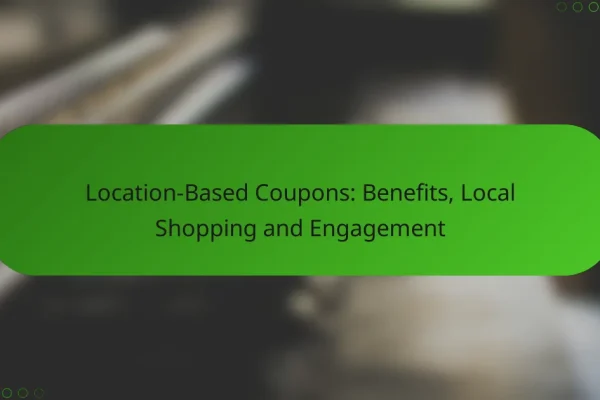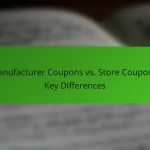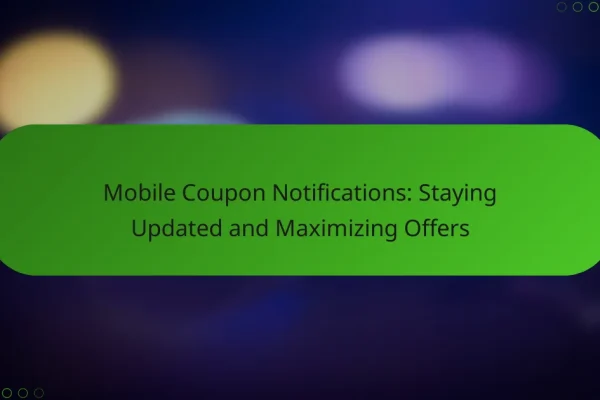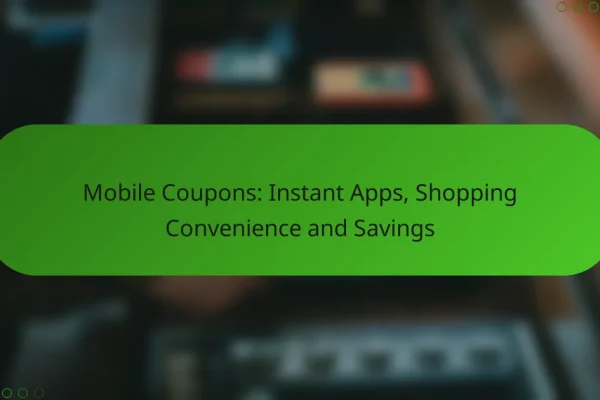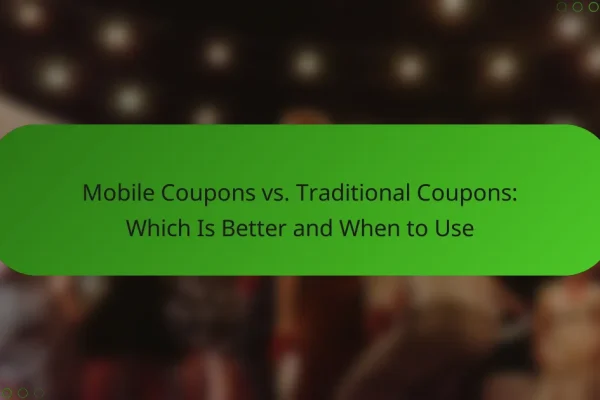How can mobile couponing enhance customer engagement?
Mobile couponing enhances customer engagement by providing a convenient and personalized way for consumers to access discounts and promotions. This approach not only increases interaction with brands but also fosters loyalty through tailored offers and timely notifications.
Increased redemption rates
Mobile coupons typically see higher redemption rates compared to traditional paper coupons. This is largely due to the ease of access; consumers can store and retrieve coupons directly on their smartphones, making it simple to use them at checkout.
Retailers can expect redemption rates to be significantly higher, often in the range of 10-20%, especially when coupons are integrated into loyalty programs. This means that businesses can effectively drive sales and encourage repeat purchases through mobile couponing.
Personalized offers
Personalization is a key advantage of mobile couponing. Brands can analyze customer data to create tailored offers based on shopping habits, preferences, and location. This targeted approach increases the likelihood of engagement and conversion.
For example, a coffee shop might send a coupon for a free drink to customers who frequently visit in the morning. Such personalized incentives can significantly enhance customer satisfaction and loyalty.
Real-time notifications
Real-time notifications allow businesses to communicate directly with customers about new offers, flash sales, or reminders to use their coupons. This immediacy can create a sense of urgency, prompting quicker purchasing decisions.
For instance, a retailer might send a notification about a limited-time discount just as a customer is near their store. This strategy not only drives foot traffic but also reinforces the brand’s presence in the consumer’s mind.
What are the best mobile couponing platforms in the US?
The best mobile couponing platforms in the US include Groupon, RetailMeNot, and Honey. These platforms offer a variety of deals and discounts, making it easier for consumers to save money on purchases across different categories.
Groupon
Groupon is a popular mobile couponing platform that connects users with local deals and experiences. Users can find discounts on services such as dining, travel, and entertainment, often ranging from 30% to 70% off regular prices.
To use Groupon effectively, browse through categories or search for specific businesses. Be mindful of expiration dates and terms of use, as some deals may have restrictions or limited availability.
RetailMeNot
RetailMeNot is another leading mobile couponing platform that aggregates coupons and cashback offers from various retailers. Users can access both online and in-store coupons, which can lead to savings of 10% to 50% on purchases.
To maximize savings, check the app frequently for new deals and consider signing up for notifications. RetailMeNot also features user reviews and ratings for coupons, helping users identify the most effective offers.
Honey
Honey is a browser extension and mobile app that automatically finds and applies coupon codes at checkout. It works with thousands of online retailers, making it a convenient option for users who shop frequently online.
To get started with Honey, simply install the extension or app and let it run during your online shopping sessions. Honey can save users an average of 10% on purchases, but results may vary based on the retailer and available codes.
How do mobile coupons compare to traditional coupons?
Mobile coupons offer a more convenient and efficient alternative to traditional paper coupons. They can be easily accessed on smartphones, allowing users to redeem discounts instantly without the need for physical copies.
Higher accessibility
Mobile coupons are readily available on smartphones, making them more accessible than traditional coupons that require physical storage. Users can find and use them anytime, anywhere, as long as they have their devices with them.
This accessibility can lead to higher redemption rates, as consumers are more likely to use coupons that they can easily access. For example, a mobile coupon can be stored in a digital wallet app, eliminating the risk of forgetting it at home.
Instant updates
Mobile coupons can be updated in real-time, allowing businesses to adjust offers quickly based on inventory or marketing strategies. This flexibility means that consumers can receive the latest deals instantly, often through push notifications or email alerts.
For instance, if a store has excess inventory, they can send out a mobile coupon for a flash sale within minutes, encouraging immediate purchases. This immediacy is a significant advantage over traditional coupons, which may take longer to distribute and become outdated.
Data tracking capabilities
Mobile coupons provide businesses with robust data tracking capabilities, allowing them to analyze consumer behavior and coupon performance. This data can reveal which offers are most effective, helping companies refine their marketing strategies.
For example, businesses can track how many times a coupon was redeemed, the time of redemption, and the purchasing patterns associated with it. This information can lead to more targeted promotions and improved customer engagement.
What are the key metrics for mobile coupon success?
The key metrics for mobile coupon success include redemption rates, customer acquisition costs, and engagement metrics. These indicators help businesses evaluate the effectiveness of their mobile coupon campaigns and optimize their strategies for better results.
Redemption rates
Redemption rates indicate the percentage of distributed coupons that are actually used by customers. A typical redemption rate for mobile coupons ranges from 10% to 20%, but this can vary based on factors like the offer’s attractiveness and the target audience.
To improve redemption rates, ensure that coupons are easy to access and use. Consider offering time-sensitive deals or exclusive discounts to create urgency, which can encourage customers to redeem their coupons promptly.
Customer acquisition cost
Customer acquisition cost (CAC) measures the total expense incurred to acquire a new customer through mobile coupon campaigns. This metric can include marketing expenses, discounts offered, and any associated operational costs. A reasonable CAC for mobile couponing can range from $10 to $50, depending on the industry and campaign specifics.
To manage CAC effectively, focus on targeting the right audience and optimizing your marketing channels. Using data analytics can help identify which segments respond best to mobile coupons, allowing for more efficient spending.
Engagement metrics
Engagement metrics track how customers interact with mobile coupons, including click-through rates, time spent on promotional content, and social shares. High engagement rates often correlate with successful campaigns, as they indicate that customers are interested in the offers presented.
To enhance engagement, create visually appealing and relevant content that resonates with your audience. Regularly analyze engagement data to refine your messaging and improve future campaigns, ensuring they remain aligned with customer preferences.
What are the challenges of mobile couponing?
Mobile couponing faces several challenges that can hinder its effectiveness and adoption. Key issues include fraud prevention, technical integration, and consumer privacy concerns, all of which require careful management to ensure a secure and user-friendly experience.
Fraud prevention
Fraud prevention is a critical challenge in mobile couponing, as digital coupons can be easily duplicated or misused. Businesses must implement robust verification systems to ensure that coupons are redeemed only by legitimate users.
Common strategies include using unique barcodes or QR codes for each coupon, which can be scanned at the point of sale. Additionally, employing real-time tracking can help identify and mitigate fraudulent activities quickly.
Technical integration
Technical integration involves ensuring that mobile coupon systems work seamlessly with existing point-of-sale (POS) systems and inventory management. This can be complex, especially for businesses with outdated technology.
To address this, companies should consider investing in modern POS systems that support mobile coupon scanning. Collaborating with technology providers can also streamline the integration process and enhance overall efficiency.
Consumer privacy concerns
Consumer privacy concerns are paramount in mobile couponing, as users may be hesitant to share personal information. Businesses must prioritize data security and transparency to build trust with their customers.
Implementing clear privacy policies and obtaining explicit consent for data collection can alleviate concerns. Additionally, offering users control over their data, such as opting out of marketing communications, can further enhance consumer confidence in mobile couponing initiatives.
How to create effective mobile coupons?
Creating effective mobile coupons involves designing offers that are clear, appealing, and easy to redeem. Focus on simplicity and urgency to drive customer engagement and conversion rates.
Clear call-to-action
A clear call-to-action (CTA) is essential for mobile coupons to guide customers on what to do next. Use direct language that prompts immediate action, such as “Redeem Now” or “Get Your Discount.” This clarity helps eliminate confusion and encourages users to take advantage of the offer.
Ensure the CTA stands out visually within the coupon. Use contrasting colors, larger fonts, or buttons to draw attention. Position the CTA prominently, ideally at the top or bottom of the coupon, to make it easily accessible.
Test different CTAs to see which resonates best with your audience. Small changes in wording or design can significantly impact conversion rates, so consider A/B testing various options to optimize performance.
